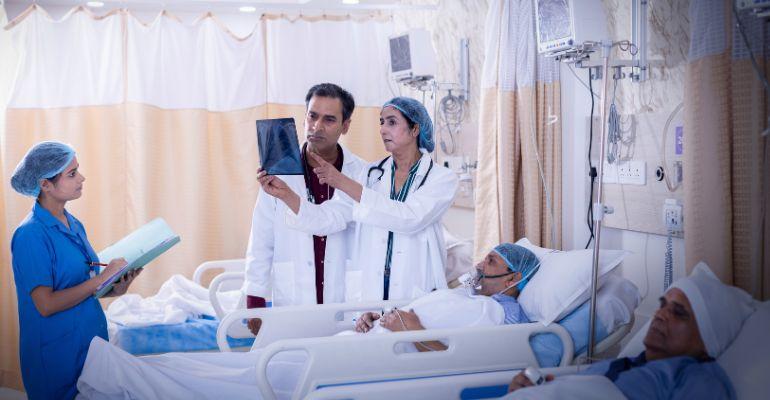The way healthcare is provided and accessed by patients has been revolutionised by telehealth, which has become a transformational force in the healthcare industry in recent years. Improving patient outcomes with technology while addressing the growing need for easily accessible healthcare treatments is what has made telehealth such a desirable commodity for providers of all sizes.
Patient care will only continue to improve as cutting-edge solutions are developed and integrated around the world. Let's look at the many aspects of telehealth and the benefits of automation in healthcare, from better patient outcomes and cost savings to increased access to care and the possibility of remote diagnostics.
Healthcare organisations face major efficiency and cost challenges
Nowadays, most healthcare organisations leverage technology for streamlined operations and cost/time savings. However, doctors frequently spend a great deal of time recording patient information, which results in more administrative work and less in-person patient contact. That's just one example of the inefficiency of traditional workflows that don't use automation and telehealth solutions to their fullest potentials.
Related: Pushing the boundaries of telehealth in hospitals and clinics
Here's how a lack of technological integration affects healthcare departments overall:
Manual data entry takes up valuable time: Clinicians have high burnout rates and less time to provide high-quality patient care due to excessive workloads and inadequate resources. Ten years ago, researchers in a groundbreaking study found that, on average, 44 per cent of a physician's time was spent on data entry. Compare that to just 28 per cent of time spent on providing direct patient care.
During a 10-hour shift, the total number of mouse clicks approaches 4,000 for one physician. So, there needs to be optimised technology and automated workflows — not simply more technology. More efficient healthcare resource allocation would boost hospital income by enabling emergency physicians to spend more time actually caring for patients.
Revenue leakage occurs due to insufficient resources: Patients outside of major cities and towns frequently receive care outside their community because rural hospitals have limited ICU beds and cannot afford to hire intensivists. These unaccounted-for ICU procedure expenses result in millions of dollars lost in ICU treatment.
A legislative report from 2012 confirmed the obvious: A decrease in patient volume often precedes a rural hospital closure, and unfilled beds might strain a hospital's capacity to meet the community's need for outpatient services. It's a multi-sided problem, as the American Hospital Association says that rural clinics accounted for one in every 12 rural jobs and generated around US$220 billion in economic activity in 2020 alone. So, rural communities suffer financially and medically when hospitals disappear.
How does automation streamline operations and mitigate financial inefficiencies for critical care delivery?
Automation can significantly transform the healthcare industry by tackling some of its most urgent problems. As previously mentioned, the workload that administrative duties place on healthcare personnel is one of the industry's main issues. Automation of a patient’s critical diagnostic data through Electronic Health Records, however, reduces the common errors associated with paper-based records by enabling healthcare personnel to access and update patient information easily.
Related: Megatrends shaping healthcare in 2024
Meanwhile, telehealth virtual visits greatly lessen the impact when there is a scarcity of intensivists and other specialists in an underserved community. This is a prime example of how telehealth can improve patient outcomes: It increases healthcare delivery to more patients in remote places. Physicians can efficiently diagnose, treat, and monitor patients for treatment risks through these telemedicine sessions, which lessens stress and allows for efficient healthcare resource allocation.
Integrating automation and telehealth means more effective healthcare
By simplifying repetitive processes like data collecting, monitoring, and drug administration — the typical list of manual administrative tasks — automation in critical care can maximise resource usage. Moreover, access to specialist treatment is made easier by telehealth, especially in rural or underdeveloped locations. Healthcare organisations can scale intensivists to provide care to several locations from one central location.
How can telehealth improve patient outcomes? Here are a few more substantial ways, particularly for smaller healthcare providers:
- Advanced monitoring systems that use artificial intelligence can identify minute changes in a patient's state and prescribe preventive care that may be used in future telemedicine. By adopting these systems, smaller institutions can improve patient outcomes and resource utilisation by offering sophisticated treatment without needing several on-site specialists.
- With the increasing proficiency of telemedicine solutions in managing large amounts of data, healthcare facilities can employ predictive analytics for improved patient flow, patient stratification, and overall operational efficiency.
- Continuity of care can be ensured for ICU patients by extending telemedicine into the home and enabling monitoring of the patients even after they are discharged. Smaller hospitals can use this technology to improve patient satisfaction, lower readmission rates, and guarantee consistent revenue from post-acute care.
- The emergence of blockchain technology leads to safer methods for exchanging patient data between various platforms. Blockchain technology can help smaller hospitals securely grow their telemedicine services, allowing them to coordinate care with larger systems and guarantee compliance with laws governing health data.
With their myriad benefits and potential for further growth, telemedicine solutions in ICU settings are set to change the future of critical care delivery. By embracing it, patients and healthcare providers can experience a new era of convenience, efficiency, and patient care.

Brian Douglas is the Chief Commercial Officer at AMD Global Telemedicine.






